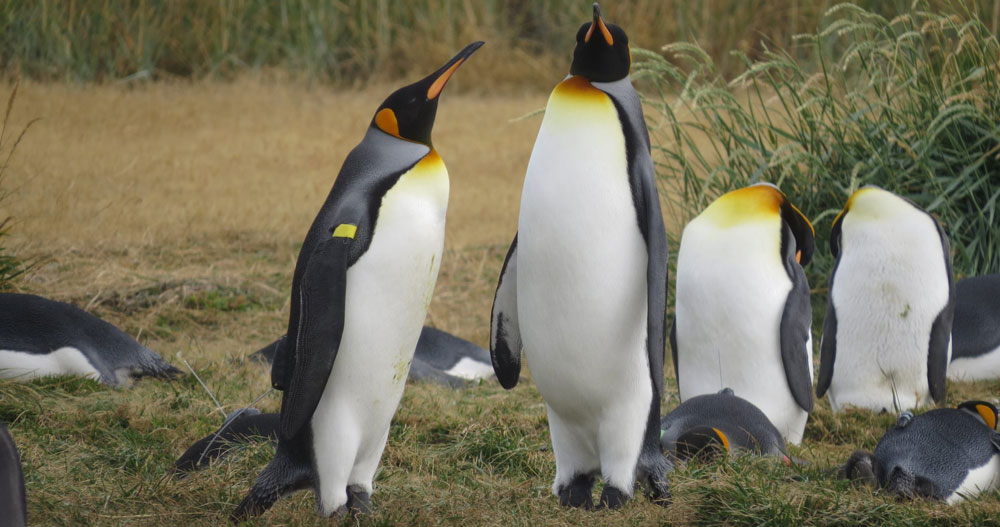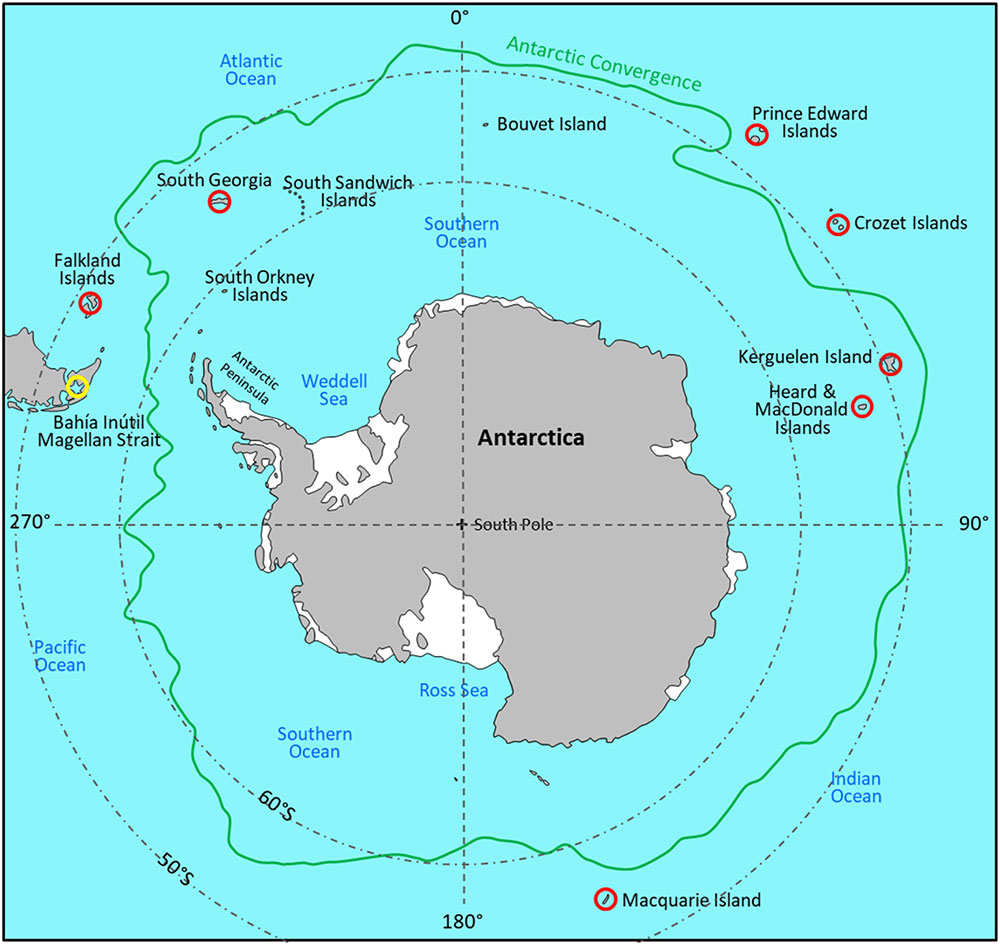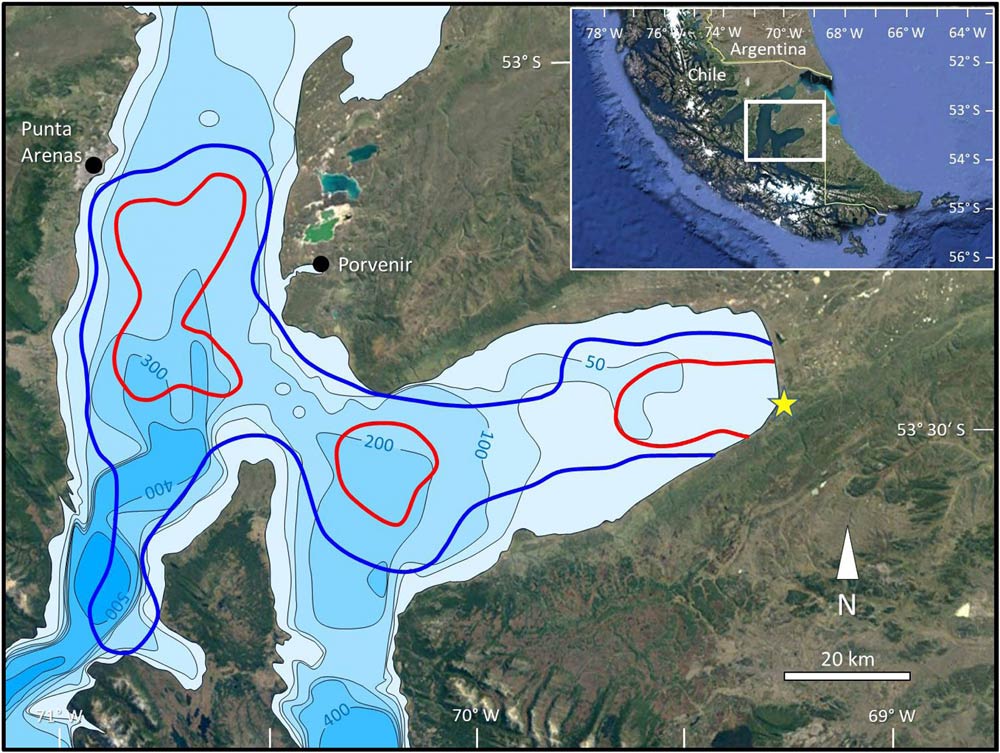← Back
A new king penguin colony in Magellan Strait?

King penguins are living around Antarctica, breeding on some of the sub-Antarctic islands. A new colony seems to have been established in Magellan strait, showing the high plasticity of the species. Argos enables to better understand the new colony behaviour.
King Penguins (Aptenodytes patagonicus) are living in the Southern Ocean. They are breeding on sub-Antarctic islands, from 46°S, on Prince Edward and Crozet Islands to 54°S, on South Georgia and Macquarie Island. They feed mainly at the Antarctic Polar Front and vicinity, travelling hundreds of kilometres between their breeding and foraging sites.

Map of the Southern Ocean and main king penguin colonies (red circles), plus the one at Bahía Inútil (yellow circle). The green line shows the approximate position of the Polar front, where most of the colonies feed (from [Pütz et al., 2021])
The population has globally stabilized after a drop in the 19th century. If some colonies underwent dramatic declines in the last decade (such as the one at Ile aux Cochons, Crozet Islands, see What future for Crozet island’s king penguins?), others have increased like the population on South Georgia. Moreover, some former breeding sites seem to have been re-colonized. For example, since 2010 a breeding colony became (re-)established at Bahía Inútil, Strait of Magellan, Tierra del Fuego, Chile. The first described specimen of king penguins was likely caught in Patagonia (hence the Latin name of the species) during James Cook’s first voyage. Additionally some archaeological evidence hints of a former use of the area in Patagonia by king penguins.
Tracking king penguins from a new colony
Thirty-two king penguins from Bahía Inútil were fitted with telemetry tags, including Argos ones. Except for one (which travelled more than 8000 km within two oceans in an eight-month period), all tagged birds foraged throughout the year exclusively in the Magellan Strait in three high-utilization areas. About 85% of all trips performed during the study lasted at most 10 days. The breeding individuals never had to travel more than 100 km from the breeding site, and trips lasted roughly half as long as the foraging trip durations of conspecifics from other breeding sites. This results in an increase in chick provisioning rates.
The dive-recording devices showed shallower dives, while the individuals from other colonies dive usually much deeper. On-site analysis showed a main diet not of myctophids, but of sprats. All these adaptations constitute a substantial change in the king penguin foraging habits.

Southern tip of South America (insert) with study area in the Magellan Strait. Kernels (blue = 90%, red = 50%) of adult King Penguins from the colony in Bahía Inútil, Magellan Strait, Chile (position indicated by yellow star). Water depth is indicated by shades of blue. (from [Pütz et al., 2021]
King penguin adaptation capabilities
The adaptations of king penguins to the Magellan strait environment shows the species behavioral plasticity. The shorter, shallower foraging trips resulted in king penguins from Bahía Inútil spending much less energy foraging and more regular provisioning of their chick with food. This ideally should increase growth rates and breeding success. However, relatively low chick survival and breeding success are observed which may be linked to a higher predation, due to introduced predators on land, and to the presence of different infectious diseases not recorded elsewhere for this species. These factors may counterbalance the more advantageous foraging environment.
From where the king penguins immigrated to Bahía Inútil remains as yet unknown. However, it shows their exceptional capabilities to adjust to different environmental conditions up to the point of even establishing a new breeding site. Whether the colony will persist depends on the protection from terrestrial threats as well as from possible competing use of the area by fisheries, and the threat of oil pollution which might increase with more ships going through the area.
Reference
- Klemens Pütz, Camila Gherardi-Fuentes, Pablo García-Borboroglu, Claudia Godoy, Marco Flagg, Julieta Pedrana, Juliana A. Vianna, Alejandro Simeone, Benno Lüthi, 2021: Exceptional foraging plasticity in King Penguins (Aptenodytes patagonicus) from a recently established breeding site in Tierra del Fuego, Chile, Global Ecology and Conservation, Volume 28, 2021, e01669, https://doi.org/10.1016/j.gecco.2021.e01669
Main Photo: four study king penguins in different positions with both models of Argos PTT used (credit Marco Flagg)
